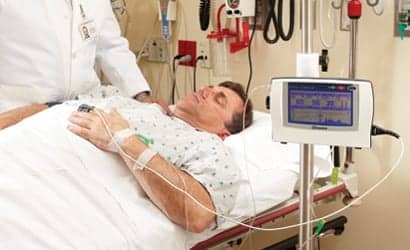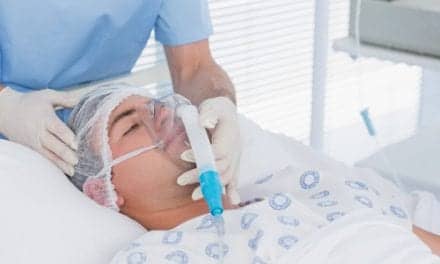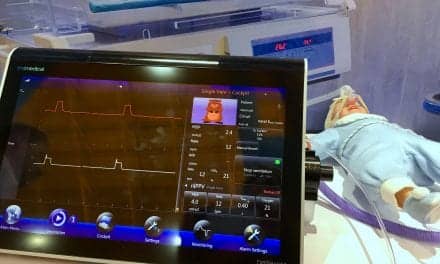A comprehensive and collaborative strategy for choosing the appropriate capnography equipment can ensure the investment fits the needs for every department and improves patient safety hospital-wide.
By Pamela S. Lindemann, BA, RRT
Selecting a capnography monitor that can be used throughout a multifunctional community hospital can be a difficult task, but it’s one that numerous healthcare professionals are facing. The use of capnography to measure the carbon dioxide levels of patients is gaining traction as standard of care within several hospital departments. Since 2004, The Joint Commission has recommended the use of capnography to monitor patients who are self-administering analgesia for pain.1 More recently, the American Society of Anesthesiologists amended their standards for Basic Anesthetic Monitoring in October 2010 (that went into effect July 1, 2011) to recommend the use of capnography during moderate or deep sedation.2 Finally, the American Heart Association updated its guidelines in 2010 to recommend the use of capnography during cardiopulmonary resuscitation.3
While these guidelines may differ in many ways, they share a common goal: patient safety. Capnography provides essential monitoring of the health of a patient’s breathing including respiratory rate and the concentration of partial pressure of CO2 in exhaled respiratory gases. When used properly, it can be one of the key clinical measurements that physicians, nurses, respiratory therapists, and other clinicians use when assessing a patient’s condition.
As hospitals around the country work to conform to these guidelines, they are being met with an increasingly complex array of decisions. Do we update existing monitoring equipment to include capnography? What are the costs beyond the initial purchase price? Can one system fulfill the needs of a diverse group of internal stakeholders? What brand of capnography monitor provides the best value? And perhaps the biggest question of all is: who is best qualified to lead the process of selecting a capnography monitor?
As the head of the respiratory therapy department at Riverside Medical Center in Kankakee, Ill, I not only took on the task of leading the selection of a capnography monitor, I enthusiastically embraced the challenge. Respiratory therapists are uniquely qualified to evaluate devices that measure breathing in patients. Not only are we able to understand and react to the data these devices give us, but we are the ones, in most cases, who will be chartered with operating and maintaining the devices. Even with the plethora of data supporting the use of capnography, many other clinicians do not understand the benefits that capnography provides. By the nature of our work, RTs need to know capnography monitors intimately and be able to react to the data provided so that appropriate clinical actions can be taken.
Our Facility
Riverside HealthCare is a fully integrated healthcare system serving patients in a four-county area. The facility is a 325-bed hospital that provides a full scope of inpatient and outpatient care. The hospital has programs in the area of cardiovascular, oncology, neurosurgery, and orthopedics. It is the area’s only Magnet Recognized hospital and has been named a top 100 hospital 4 years in a row. The hospital has a stellar reputation in eastern Illinois of providing excellent patient care.
While common sense led us to believe that an economical solution would be to upgrade some of our existing monitoring equipment to include capnography, the reality of the situation was that upgrading was one of the most expensive options that we considered. In some cases, adding a capnography module to existing equipment was more than three times the price of bringing in a dedicated capnography monitor. In addition, updating large, bulky systems would not give us the portability we sought, so the upgrading option was quickly ruled out.
The Selection Process
In the very early stages of reviewing our options for capnography, we were initially budgeted for one monitor for use in the respiratory therapy department. The primary factor that drove the purchase of that first unit was price. However, we soon found out that price alone was a poor basis for selecting a capnography monitor. The first unit we purchased was poorly constructed, was complicated to use, and had numerous breakdowns in the few months that we used it. When I was given the go-ahead by hospital administration to purchase additional units, I took a more holistic approach in selecting a capnography monitor. While the respiratory therapy department would lead the effort of selecting appropriate monitors for the hospital, we made sure to get input from departments and personnel who would be using the units.
(Read Riverside Medical Center’s Capnography Selection Criteria Summary.)
We identified the following as key stakeholders in our selection process: Crash Carts; Post-Acute Care Units (PAC); Post-Anesthesia Care Units (PACU); Trauma Rooms; and Emergency. We quickly determined that there would be several cost considerations to keep in mind during the evaluation process. For example, the initial price of a capnography monitor is important, but perhaps more important is the cost of supplies and maintaining the unit. In some cases, manufacturers offered only a 1-year warranty on their monitors, and then sold expensive maintenance contracts. In other cases, the initial costs of purchase seemed relatively low, but the expense of supplies such as cannulas made the units prohibitively expensive.
We soon found out that the cost for the single patient use disposables varied from a low of just a few dollars to a high of $20. To get a better idea of total costs, we requested that the departments that would be using capnography estimate how many cannulas they would use in a typical year. Those estimates were a key factor in helping us to determine the hospital’s total costs. We also evaluated cannulas from both sides of the cost continuum and found very little difference in terms of quality, patient comfort, or ease-of-use.
For some departments, we determined that aside from providing capnography readings, the units also had to provide accurate SpO2 and pulse rate monitoring. In the emergency department, space considerations required units that would provide end-tidal CO2 (EtCO2) and SpO2 readings. Also, patients with acute pain who were using patient controlled analgesia (PCA) units were identified as needing to have SpO2 monitoring as well as EtCO2 monitoring. Since suppressed respiratory function caused by oversedation is a significant risk for these patients, it was determined that since some pain patients do not tolerate the cannula, it was important to have SpO2 monitoring as a backup.
The use of capnography for patients receiving opiates for pain stems from The Joint Commission’s release of a Sentinel Event Alert in 2004. This alert recommends ventilation monitoring for patients receiving opiates for pain.1 The alert stated that the proper use of capnography to measure EtCO2 can alert clinicians to early warning signs of respiratory depression. Respiratory depression can lead to a variety of complications, including coma and cardiac arrest.
One area that we determined was in critical need of capnography monitors was on crash carts. In the CPR environment, we recognize that the absence of cardiac output and pulmonary blood flow often results in CO2 levels that fall abruptly. Properly administered, capnography can help to identify lower EtCO2 levels so that appropriate changes in CPR such as rate or force of compression can take place. In the 2010 update of the CPR Guidelines, the American Heart Association recommends “the use of quantitative waveform capnography for confirmation and monitoring of endotracheal tube placement.”3
After thoroughly evaluating capnography monitors from four manufacturers, we selected the RespSense and LifeSense models made by Nonin Medical in Plymouth, Minn. The RespSense monitor provides EtCO2 measurements while the LifeSense monitors provide both EtCO2 and SpO2 measurements. These units best met our criteria for construction, including graphics and portability, warranty policies (3 years), and consumables pricing.
Once we demonstrated the value of capnography to our hospital administration, the number of units we were given the green light to purchase increased from 10 to 23. They are distributed in the hospital as follows:
Functional Area
- Crash Carts: 10 units
- PAC: 5 units
- Trauma Rooms: 2 units
- PACU: 4 units
- Emergency: 2 units
The units in the trauma rooms and emergency are the LifeSense models, which have the additional SpO2 capability. Although our hospital administration allowed us to purchase more than twice as many units as we had initially planned, we did determine that we could use as many as 50 monitors throughout the hospital. It is likely that additional units will be purchased in the next few years.
Training Staff on Equipment Use
Selecting the right equipment is only part of ensuring proper use of capnography monitors in a hospital setting. In addition to training from the manufacturer or distributor, we recommend that a competency checklist be created and followed by every member of the clinical staff who will be using the monitors. The objective of the checklist should be to have each clinician demonstrate proficiency in the clinical applications of capnography, and setup and proper operation of the capnography monitors. The participant should be required to demonstrate the following:
- Monitor setup for patient use: start-up and display screens, setting of alarm limits, connection of power supply and battery operation, and selecting the patient sampling lines/sensors;
- Correct insertion and removal of the moisture trap and filter;
- Attachment of sampling line/cannula and/or sensor to the monitor and to the patient;
- Monitoring the patient;
- Common troubleshooting techniques.
Table 1 is an example of a competency checklist form that can be used.
Effective Strategy, Effective Outcome
The use of capnography as an effective tool to measure the respiratory health of patients is increasing in hospitals around the country. RTs, with our unique skill set and knowledge base, will increasingly be called upon to lend their expertise in helping to select appropriate monitors for institutions. My experience at Riverside Medical Center has shown that it can be an effective practice to engage key hospital stakeholders early on in the selection process to ensure that the unique needs and requirements of various departments are considered before the purchase takes place. While the initial purchase price is one criterion, overall cost of ownership, system reliability, and ease-of-use are all factors that need to go into the final decision-making process. Effective planning and evaluation along with engaged stakeholders will help to ensure an effective outcome. RT
Pamela S. Lindemann, BA, RRT, is the respiratory manager at Riverside Medical Center in Kankakee, Ill. For further information, contact [email protected].
References
- The Joint Commission, Sentinel Event Alert, Issue 33: Patient controlled analgesia by proxy. December 20th, 2004.
- American Society of Anesthesiology Standards for Basic Anesthetic Monitoring, Committee of Origin: Standards and Practice Parameters, amended October 20th, 2010.
- Field JM, Hazinski MF, Sayre MR, et al. 2010 American Heart Association Guidelines for Cardiopulmonary Resuscitation and Emergency Cardiovascular Care. Circulation. 2010;122:S640-S656.













